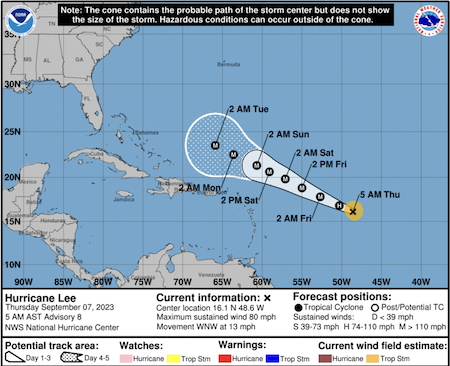Atlantic Hurricane Season: Hurricane Lee Could Become Dangerous
Another Tropical Storm in the western Atlantic has strengthened into Hurricane status and is forecast to become an “extremely dangerous major hurricane” by the end of the week, according to the USA’s National Hurricane Center (NHC).
Published 1 year ago
Tropical Storm Lee has strengthened from a tropical storm into a hurricane and is expected to become a “major hurricane” by Friday 8th September, the NHC said, as the storm intensifies at a “steady to rapid” pace.
The storm may become a Category 4 hurricane — a potentially “catastrophic” storm with sustained wind speeds of 130-156 mph — as it travels over very warm water.
Hurricane Lee is expected to pass near the northern Leeward Islands and Puerto Rico this weekend. The Leeward Islands are a group of islands located where the Caribbean Sea meets the western Atlantic Ocean and include the U.S. Virgin Islands.
Large ocean swells are expected to reach the Lesser Antilles by Friday and then the U.S. and British Virgin Islands, Puerto Rico, the Bahamas, Bermuda and Hispaniola by the weekend, the hurricane center said.
Current projections show Hurricane Lee will not make landfall but pass north of the British Virgin Islands, which is still recovering from hurricanes Maria and Irma in September 2017.


Hurricane Lee is not forecast to impact the United States at this time, CBS Miami reported. CBS Miami chief meteorologist and hurricane specialist Ivan Cabrera Lee said the storm system is expected to turn to the north and away from the U.S. coast.
Florida is currently recovering from Hurricane Idalia, which made landfall along the Gulf Coast on August 31 and left a trail of damage across the Big Bend region — the area where the Florida peninsula meets the panhandle.
The storm caused severe flooding in Florida and other states including Georgia, South Carolina and North Carolina, before moving out to sea. Several deaths have been attributed to the storm, and the financial toll of the hurricane could reach $20 billion, CBS News previously reported.
12th Named Storm of the Season
Lee is the 12th named storm of the Atlantic hurricane season, which runs from June 1 to November 30.
Meanwhile in the Pacific, Hurricane Jova has strengthened into a Category 2 hurricane but is situated far off the southwest coast of Mexico and poses no threat to land says the NHC. It was located some 600 miles south of Baja California and moving west-northwest at 13 mph with winds up to 105mph. It was expected to become a major hurricane by Wednesday night.
………………………………
Related News:
- Hurricane Lee is charting a new course in weather and could signal more monster storms (The Independent)
- Hurricane Lee’s Projected Path and Timeframe (CBS News)
- Hurricane Lee forms in the Atlantic (The Weather Channel)
- Storm Lee Strengthens to Hurricane Status (The Independent UK)
- USA: Florida Braces for Hurricane Idalia (Noonsite)
………………………………
Related Links:
- Noonsite Cruising Resources: Weather
- NOAA National Hurricane Center
- NOAA Climate Prediction Center
- Saffir-Simpson Hurricane Wind Scale
- Atlantic Multidecadal Oscillation
- Yale Climate Connections
………………………………
Find out all news, reports, links and comments posted on Noonsite, plus cruising information from around the world, by subscribing to our FREE monthly newsletter. Go to https://www.noonsite.com/newsletter/.
Related to following destinations: Abaco Islands, Andros, Bahamas, Bermuda, Berry Islands, Bimini Islands, British Virgin Islands, Cat Island, Conception Island, Crooked Island District, Eleuthera, Exuma, Florida, Freeport (Bahamas), Grand Bahama Island, Great Inagua, Half Moon Cay, Hamilton - Bermuda, Ireland Island (Sandys Parish), Isla de Mona, Jost van Dyke, Long Island, Main Island, Mayaguana, New Providence, Other Islands (BVI), Out Islands, Puerto Rico, Spanish Virgin Islands, St. Croix, St. George's Harbour, St. John, St. Thomas, Tortola, US Virgin Islands, USA, Virgin Gorda
Related to the following Cruising Resources: Atlantic Ocean West, Caribbean Sea, Hurricanes and Tropical Cyclones, Weather









